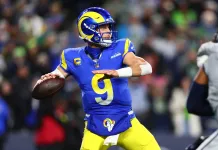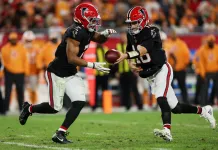Last week, one of the topics that I covered was betting early in the week. Last year, close to 55% of my wagers on the NFL and college football came before Monday at noon. The next largest section of my bets, about 30%, came from in-game betting, so let’s focus on why and how that can become a profitable tool to add to your betting toolbox.
NFL Odds | NFL Betting Splits | NFL Matchups
Before we get into the how, let’s look at the why. Week-long NFL and college football markets are exceptionally mature. By the end of a week’s worth of betting, both the sides and totals have millions of dollars bet into them, and you end with a consensus market number with minor variations from book to book.
With in-game betting, you have the exact opposite. Instead of competing with a longer, more mature market, you bet into an algorithm that each sportsbook uses to quickly generate a line based on the closing number for the game and past results in similarly lined games. While the algorithms are similar from book to book, they are not the same during a commercial break in an NFL game. It’s not uncommon to see 1-to-2-point differences on sides and totals.
For stand-alone games, Thursday Night Football, Sunday Night Football, and Monday Night Football, sportsbooks will generally have an employee assigned to adjust numbers if there is a major injury or weather situation, but they will not make adjustments off the algorithm for small injuries. In short, instead of competing with one of the most accurate markets in the world, you compete with an algorithm and, occasionally, a single person.
Understanding the weakness in an algorithm is the easiest way to exploit in-game betting. The biggest weakness I’ve found in the last three years is cluster injuries at offensive line and in the secondary. When you enter a game with one or more injuries in either of those groups and you have an additional player leave the game, it creates a massive edge.
No NFL player in the secondary or offensive line is worth more than a half point on a full game line, so it’s logical that, in a shortened timeframe, the in-game algorithm would not adjust for the loss. That being said, if a team is down two starting offensive lineman and then loses an additional lineman during the game, that injury is worth making an adjustment. Not only is that team relegated to three backup players who have not practiced or communicated as a unit, but coaches now must adjust the game plan to give those players the best chance of success. Creative runs, trick plays and long developing routes are now off the table.
In this scenario, I will immediately look to the Team Total Under in the shortest timeframe available. If the injury occurs in the first half, let’s play the first half Under for that team. It limits the time for the new unit to gel or the injured player to return.
This week, I am keeping a close eye on Seattle. After having a shaky offensive line to begin with, they lost both starting tackles during a loss to the Rams in which they scored 13 points with them in and 0 with them out. Another loss on the offensive line would be catastrophic for a team that wants to run the ball and keep Geno Smith clean. If the injuries are in the secondary, then I am looking to Team Total Overs or in-game player props if they are available. The idea is to bet the most correlated outcome due to the injuries.
The other way that I have found to take advantage of the algorithm is to understand and utilize possession math. At kickoff, I will mark each team that is going to get possession to start the second half. That becomes key early in the second quarter when you can accurately predict the number of remaining possessions in a half for each team. If the Chiefs are getting the ball to start the second half and are receiving a punt with 10 minutes left in the second quarter, then they will most likely have the ball three out of the next four possessions. With an offensive like Kansas City, that’s a solid entry point.
Placing in-game first-half bets with possession math has also been highly profitable. If a game is close after the first quarter and you can project who will have the twice, then you have an advantage as well.
Finally, variance in-game can be a profitable play as well. Look no further than last night’s game with the Eagles and Vikings. I played Over 49 going into the game, which I gave out on The Lombardi Line Thursday morning, and leaned toward the Eagles, but didn’t want to lay the 6. The Eagles took a 3-0 lead and seemed in control of the game until a missed FG set up the Vikings with a short field. Minnesota scored to go up 7-3 and, at that point, I laid -2.5 with the Eagles. I was able to get a sub-field goal number on a team laying between 6 and 8 points all week simply because of the variance of the early possessions. The Eagles went into the half up 13-7 and ended up winning by 6. At best, any Eagles number pushed with the 6-point win, but my in-game number of -2.5 easily cashed. In-game betting can allow you to play a game you would usually pass because a playable line presents itself due to the in-game situation up to that point.
As a bettor, you need to maximize every advantage possible, and in-game betting allows you to take advantage of holes in a market that is not as mature as a line that has been posted for a full week. Adding it to your toolbox will make you a more profitable bettor in the long run if you are able to spot the edges.





